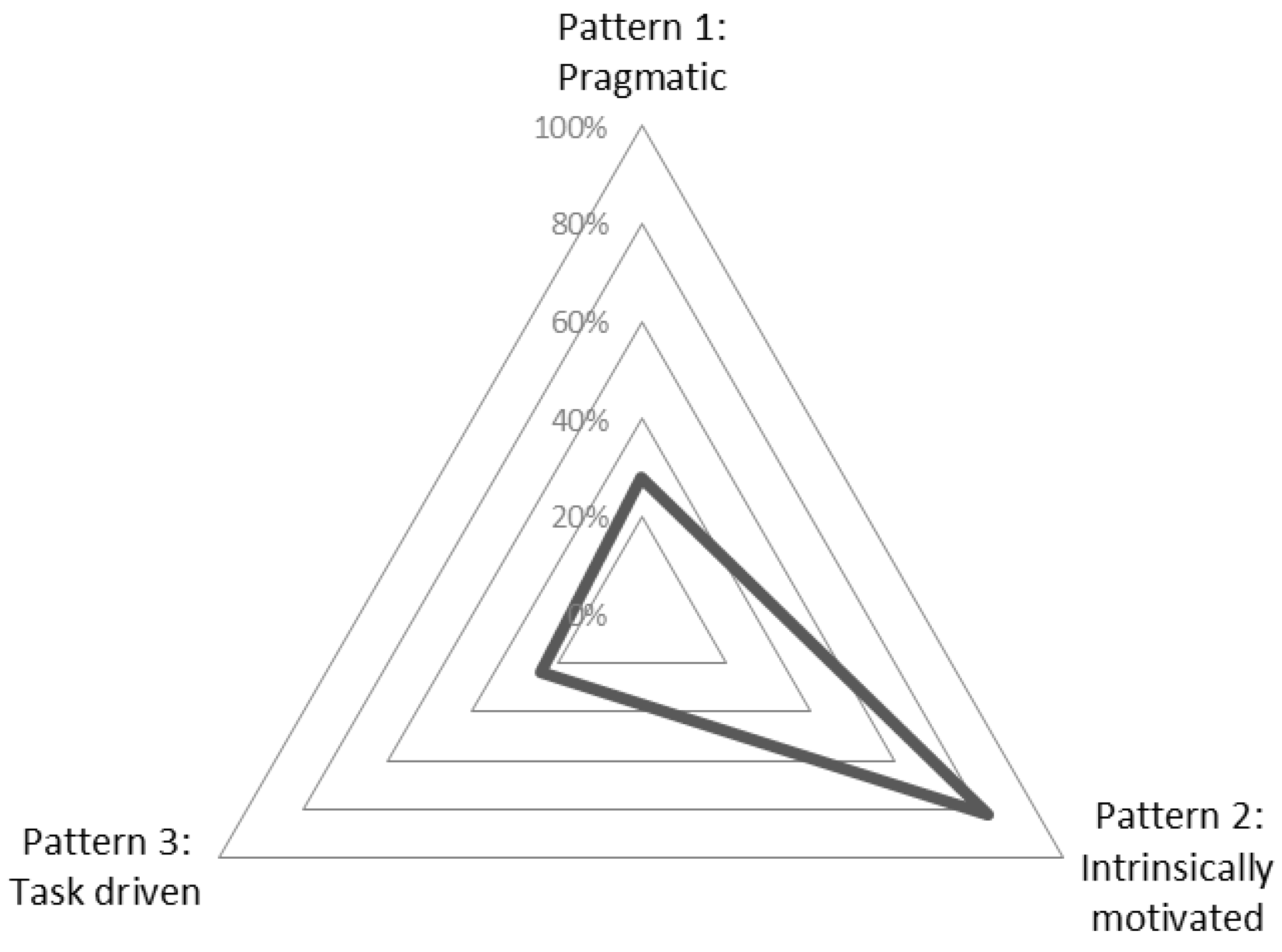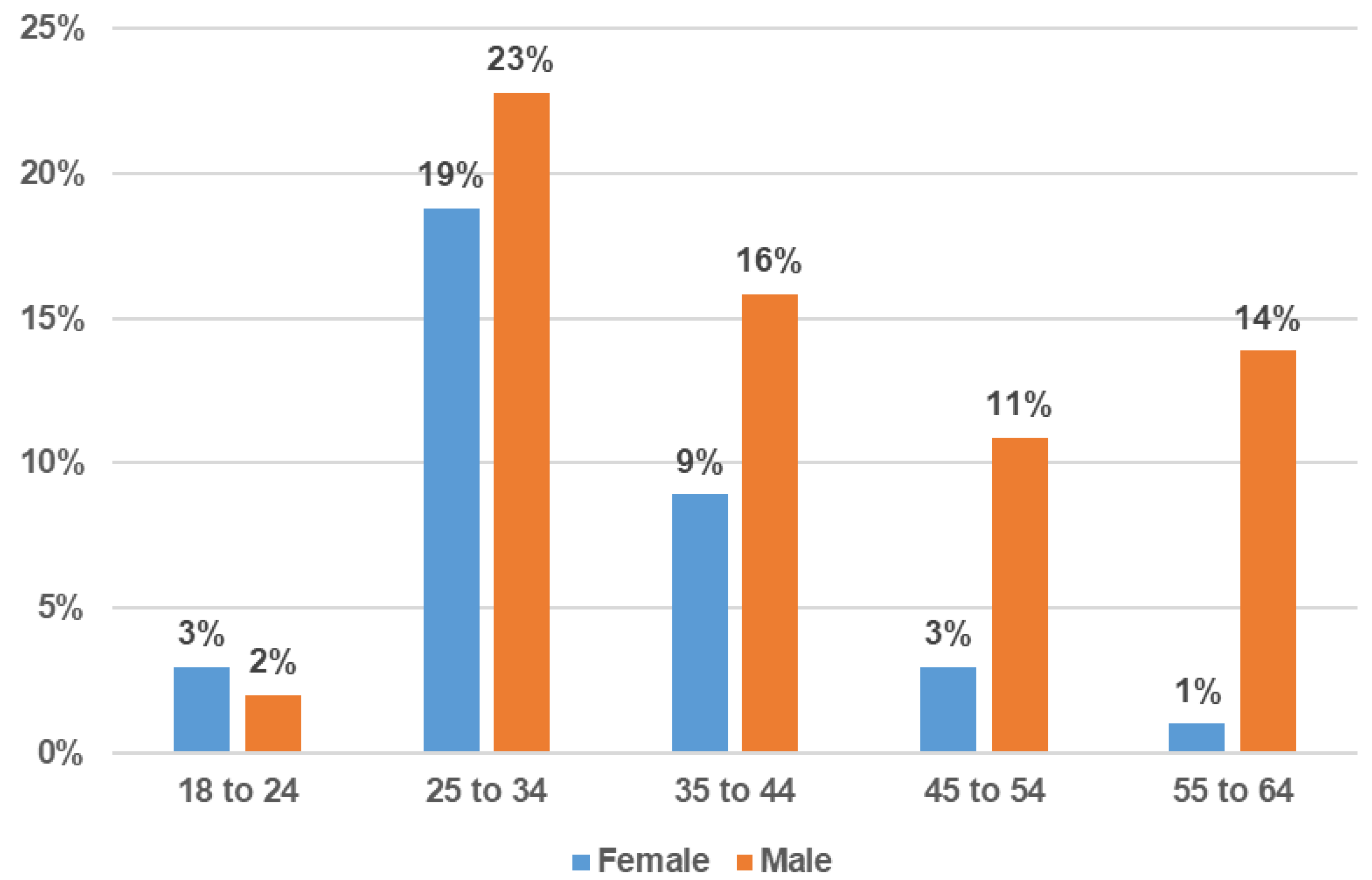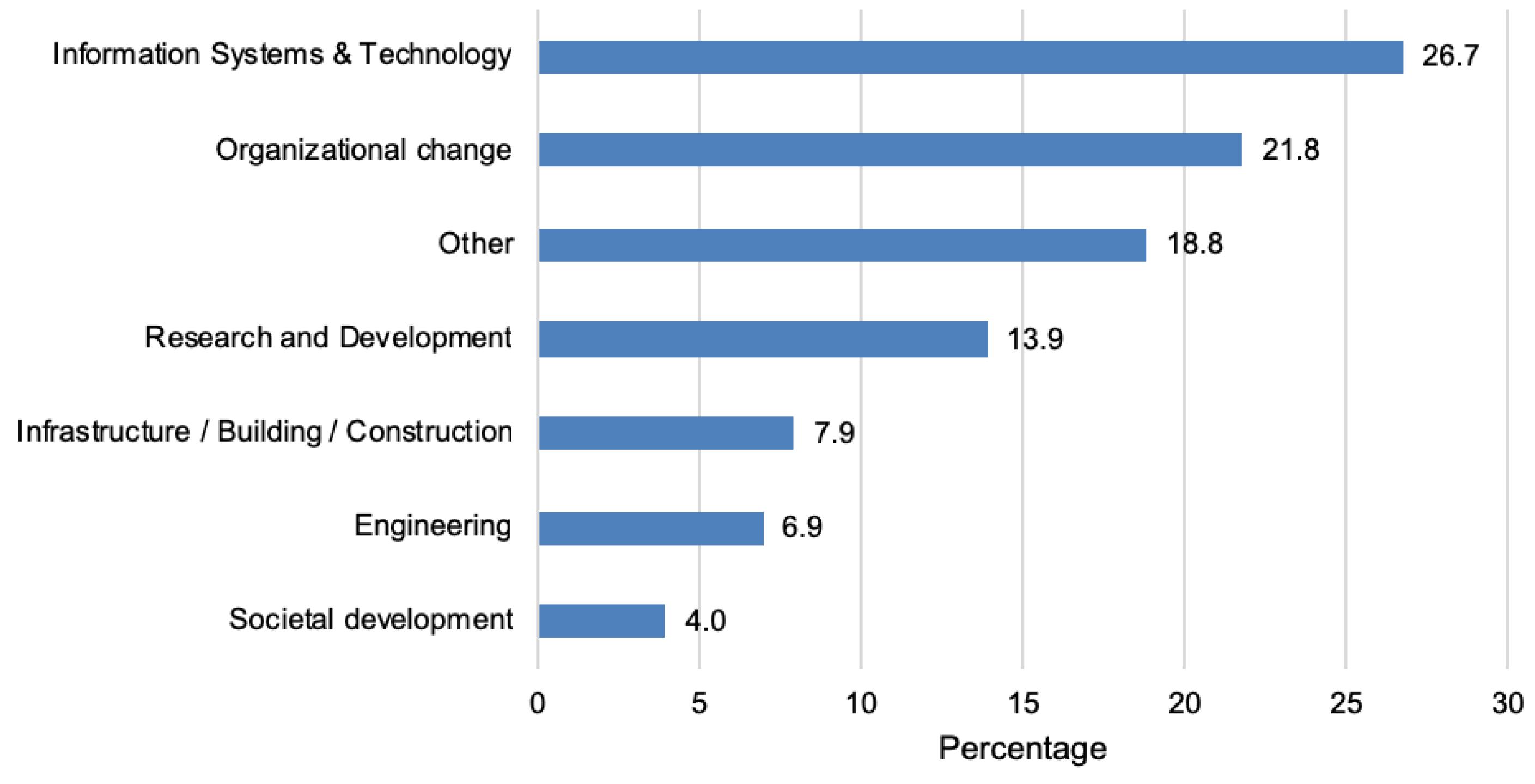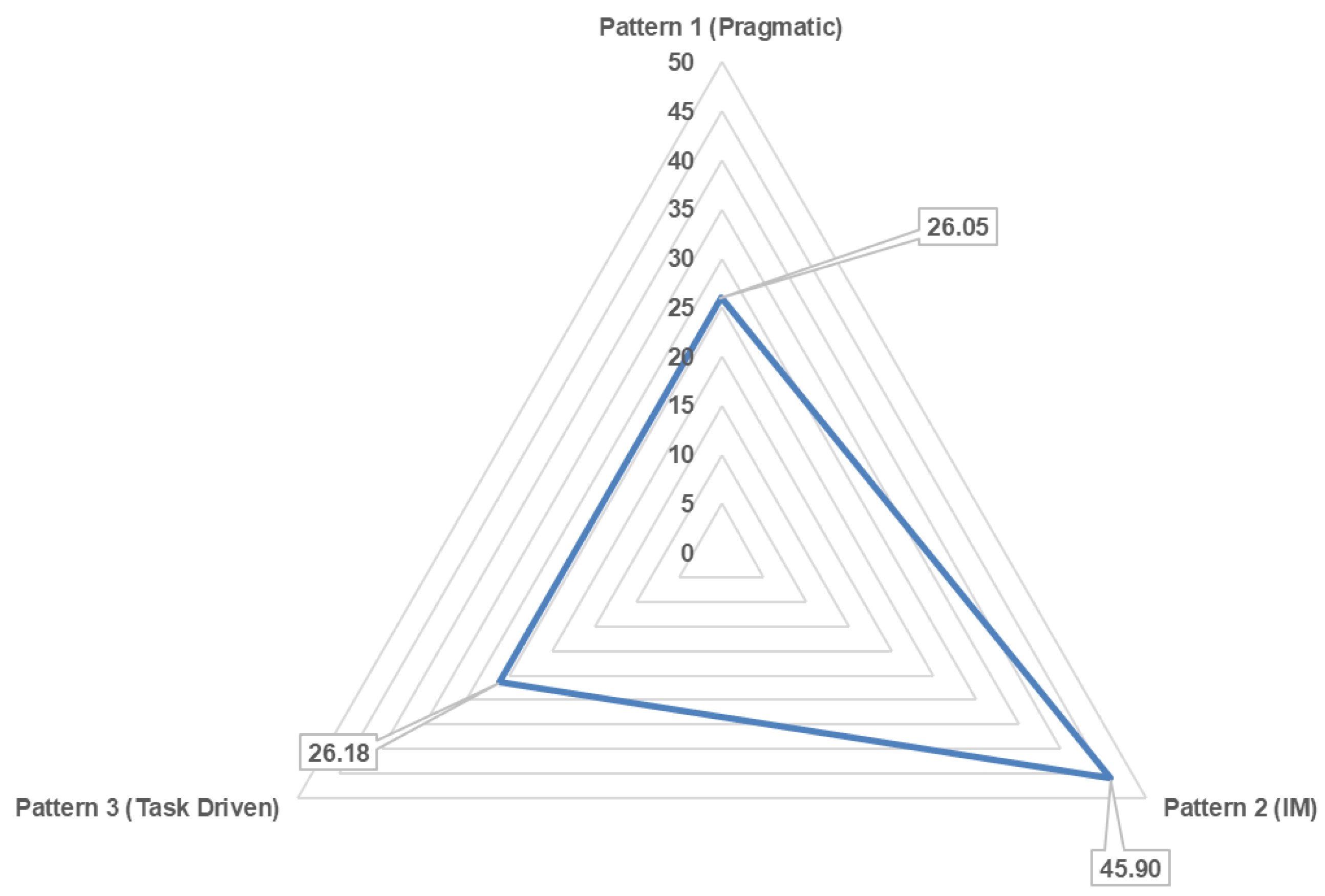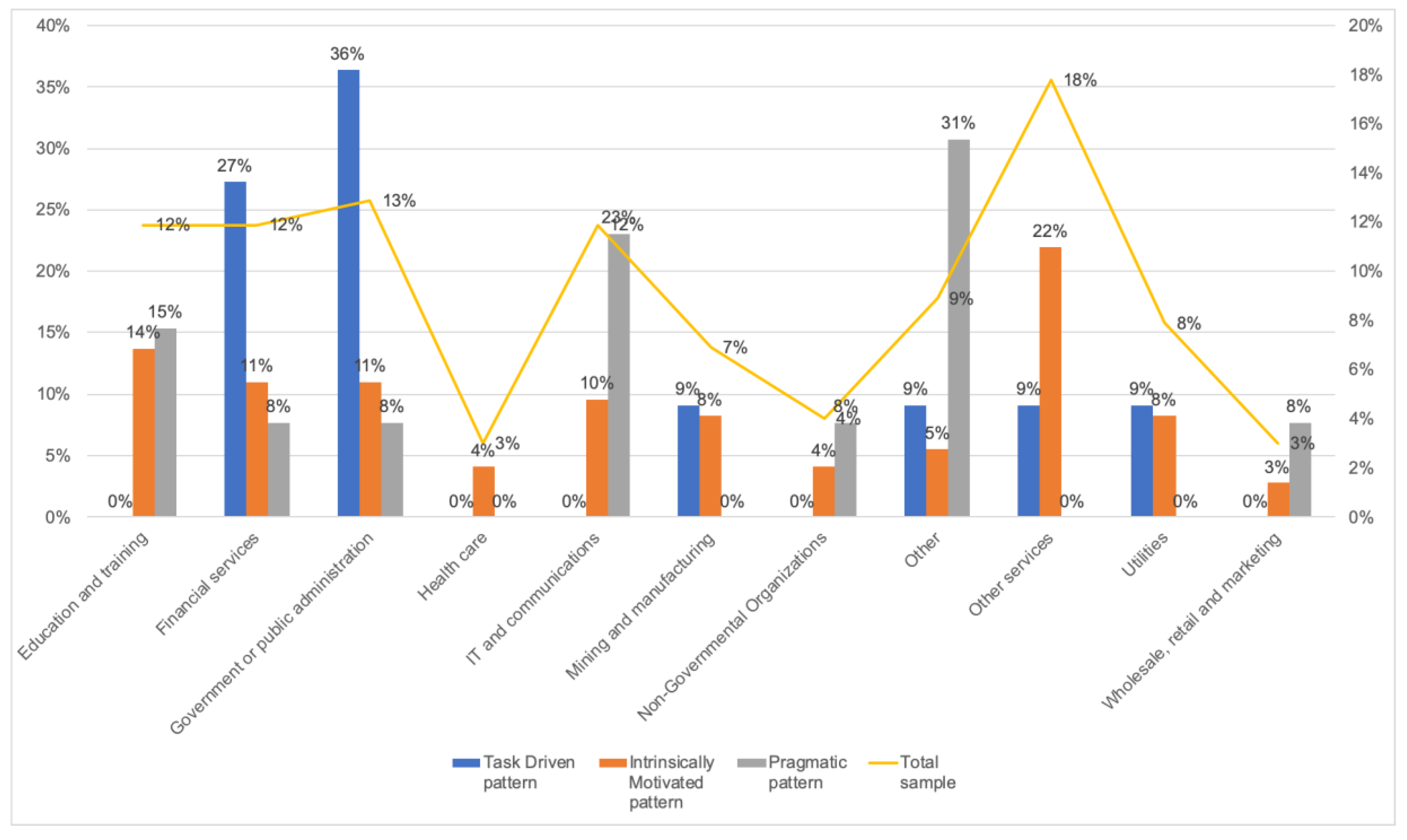2.1. Sustainability in Project Management
The rationale for suggesting a relationship between sustainability and project management is the growing consideration of sustainability in business practices. Misopoulos et al. [
16] recognize that there is a plethora of drivers for companies to implement sustainable practices, and senior business professionals acknowledge that “business will need to play the leading role in advancing sustainability in the future” [
17]. Projects play an instrumental role in the development and implementation of more sustainable business practices and thereby the sustainable development of society [
6]. The emerging literature on sustainability and project management, describes the relationship between sustainability and project management in two ways [
18,
19]: The sustainability of the project’s product (the deliverable that the project realizes) and the sustainability of the project’s processes of delivering and managing the project. These two focus areas opens a gap in the research with regards to the skills, knowledge and behaviors that are needed by project managers to manage sustainable projects.
Integrating sustainability considerations into the project’s product or deliverable logically influences the specifications and design of the project’s deliverable [
20,
21], materials used [
22], benefits to be achieved [
8,
23] and quality and success criteria [
24]. These product-related aspects of the project are also considered the content of a project. Studies on the integration of sustainability into the content of the project often focus on operationalizing the triple bottom line (TBL) concept [
25] by developing sets of indicators on the different TBL perspectives: Social, environment and economic (For example [
24,
26,
27,
28,
29]). Considering sustainability in these aspects will most of all result in a more sustainable project in terms of a more sustainable deliverable, however, this approach bears the risk of lacking the holistic approach of the integration of the economic, environmental and social perspectives.
Sustainable project management, however, is not about the management of sustainable projects; it is about managing projects sustainably [
30]. Sustainable project management is about integrating the dimensions of sustainability into the processes of project management and delivery [
4], such as the identification and engagement of stakeholders [
31,
32], the process of procurement in the project [
33], the development of the business case [
23], the monitoring of the project [
32], the identification and management of project risks [
34], the communication in and by the project [
35] and the selection and organization of the project team [
30].
Several authors conclude that the sustainability perspective on both the content and the process of a project implies a scope shift in project management: From managing time, budget and quality, to managing social, environmental and economic impact [
4,
8,
36]. However, adding new perspectives to the way projects are managed also adds complexity [
8,
31]. Project management therefore needs to adopt a more holistic and less mechanical approach [
37] and evolve from an approach that can be characterized by predictability and controllability, to an approach that is characterized by flexibility, complexity and opportunity [
13].
Integrating sustainability into project management raises the question of responsibility [
38]. Hwang and Ng [
10] conclude that the project manager must manage the project in the most efficient and effective manner with respect to sustainability. However, no clarity is given whether the project owner or sponsor should actually carry the bulk of the responsibility for this. No clarity is also provided whether the project manager, or the project team, is responsible for the sustainability of the project.
The question of responsibility is further addressed by a number of authors [
8,
39]. The conclusion of these studies suggests that all roles in the project can influence the sustainability of the project [
39]), with most influence expected from both the project owner and the project manager [
8]. The project manager is, also without formal responsibility for most content aspects of the project, well positioned to have a strong influence on the sustainability of the project and its project management. Given the growing attention for sustainability in professional standards and codes of conduct (for example [
40,
41]), it can be questioned whether the project manager can ignore a certain responsibility for applying this influence in order to make his/her project more sustainable [
8]. Silvius and Schipper [
30] conclude that integrating sustainability into project management requires a mind shift from the project manager. In their view, a sustainable project manager realizes that the project he or she manages, impacts society and takes responsibility for minimizing negative impacts while boosting positive contributions, with ethics and transparency as a basic touchstone [
30].
2.2. Sustainability in Behavior
Implementation and reinforcement of corporate sustainability efforts largely depend on the degree to which employees embrace sustainable behavior [
42]. Sustainable project management therefore is, in essence, about the behavior of the project manager [
43]. The consideration of sustainability in the behavior of individuals has mostly been studied in the context of consumer behavior [
44,
45,
46,
47,
48]. One of the most influential frameworks that are used to explain sustainable behavior is the theory of planned behavior (TPB) [
14]. TPB aims to better understand, describe and predict behavior, by linking intended behavior to underlying beliefs. According to the TPB, (intended) human behavior is guided by three kinds of beliefs:
Behavioral beliefs: Beliefs about the likely outcomes of the behavior and the evaluations of these outcomes. These beliefs produce a favorable or unfavorable attitude toward the behavior.
Normative beliefs: Beliefs about the normative expectations of others and motivation to comply with these expectations. These beliefs result in perceived social pressure or a subjective norm.
Control beliefs: Beliefs about the presence of factors that may facilitate or impede performance of the behavior and the perceived power of these factors. These beliefs give rise to perceived behavioral control.
In combination, these beliefs lead to the formation of a behavioral intention [
14]. As a general rule, the stronger the different beliefs about a certain behavior are felt, the stronger a person’s intention to perform the behavior in question is.
TPB is a popular way to examine underlying constructs of behavior. Some studies have examined the efficacy of the TPB in the form of a meta-analysis. The most inclusive meta-analysis has been conducted by Armitage and Conner [
49]. Based upon an analysis of 185 independent studies, the predictive value of the TPB showed to be significant.
2.3. Sustainability Stimuli of Project Managers
Although the relationship between beliefs about sustainability and human behavior has mainly been studied in the context of consumer behavior, some studies also applied TPB in studies of sustainable behavior in the professional context of the individual (for example [
13] and [
50]. The study of Silvius et al. [
12], into factors that stimulate project managers to consider sustainability, also builds upon the TPB model as underlying theory for the identification and categorization of sustainability stimuli. In order to be able to identify different subjective perspectives on sustainability, the study deployed Q-methodology as the research strategy. Q-methodology differs from R-methodology (surveys and questionnaires) in that it intends to show different answering patterns among the population.
The study of Silvius et al. [
12] identified three distinct ‘patterns’ of project managers with regards to their reactions to sustainability stimuli, that they labeled as “Intrinsically motivated”, “Task driven” and “Pragmatic”:
The intrinsically motivated project managers were stimulated to address sustainability because they care about nature, the planet and the future and because they feel that caring for sustainability is something they should do. In this pattern, the motivation to consider sustainability is dominated by behavioral beliefs. The characteristics of the project, or the opinion of others, do not play a large role. This group is intrinsically motivated for sustainability and will do what they consider the ‘right thing’.
The task driven project managers were stimulated to address sustainability by the project’s requirements or objectives. These project managers will consider sustainability when it is part of the project’s assignment, when the client asks for it or when they are rewarded for it. The task driven pattern is therefore pretty much the opposite of the intrinsically motivated pattern. For task driven project managers, the motivation to consider sustainability is mostly driven by the normative and control beliefs. This group therefore can be stimulated to consider sustainability by external pressure or rewards.
The last pattern of project managers took a pragmatic approach to the consideration of sustainability in project management. These project managers were not strongly self-motivated for sustainability but would consider it when they see a good application for sustainability. The motivation to consider sustainability is mostly driven by the control beliefs. These project managers are stimulated by practical knowledge, tools and results.
Table 1 provides an overview of the statements that were highly ranked by the respondents.
Table 1 also shows the category of each statement, which refers to the underlying belief (Behavioral, Normative or Control) in the TPB model [
14] on which the statement was based.
From this table, it shows that the intrinsically motivated project managers were stimulated to consider sustainability predominantly by their personal attitude towards sustainability. The contrasting pattern, task driven, was predominantly stimulated by the normative expectations of others, for example the company the project manager work for or the customer of the project. Pragmatic project managers were predominantly stimulated by factors that facilitate or impede the consideration of sustainability.
As the study of Silvius et al. [
12] was explorative in nature, aimed at identifying patterns of project managers, a follow up study is needed to deepen our understanding of the three groups of project managers and their characteristics. That is the study that is reported in this article. The following section describes the research approach and data collection strategy that the study applied.
